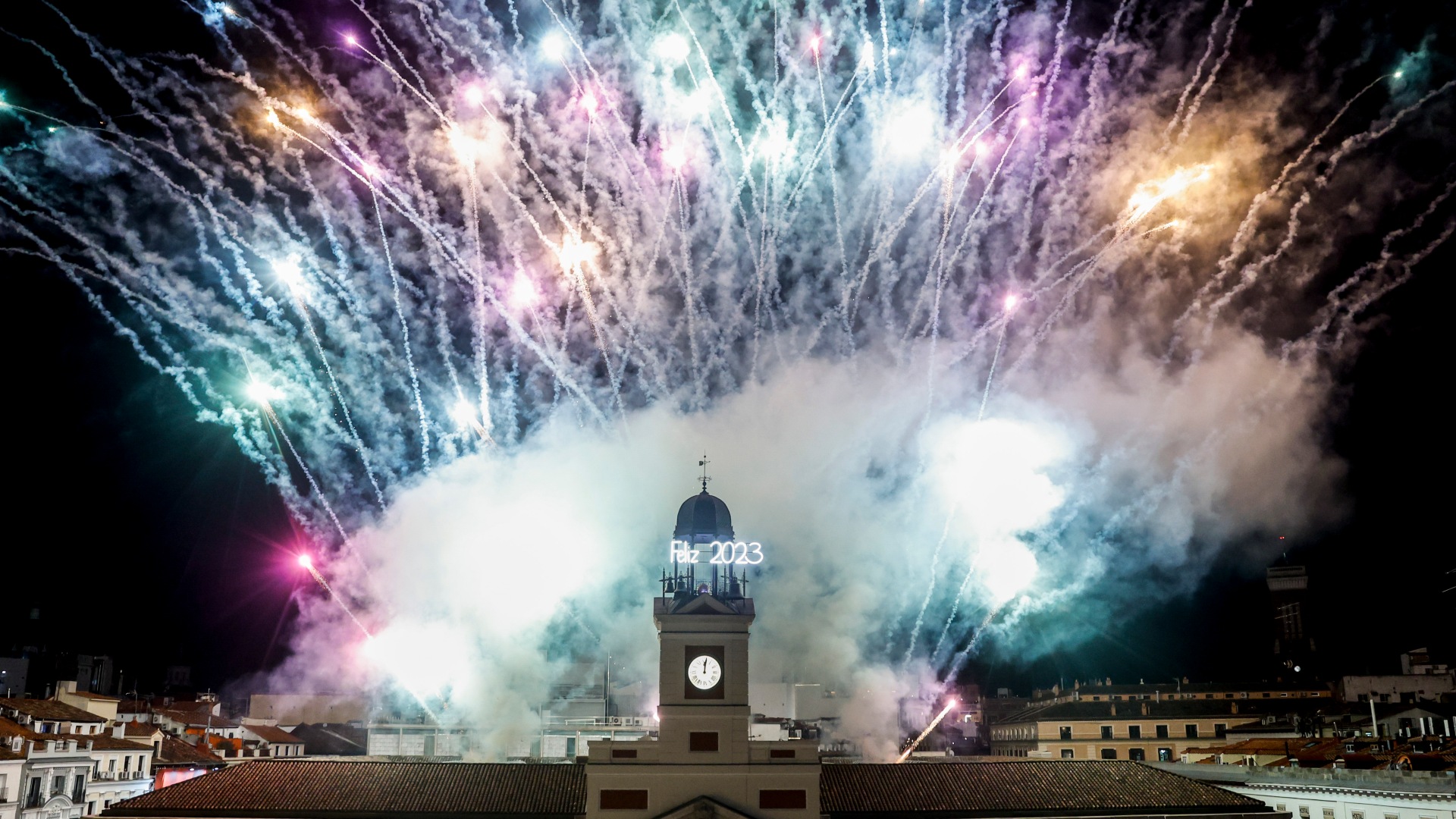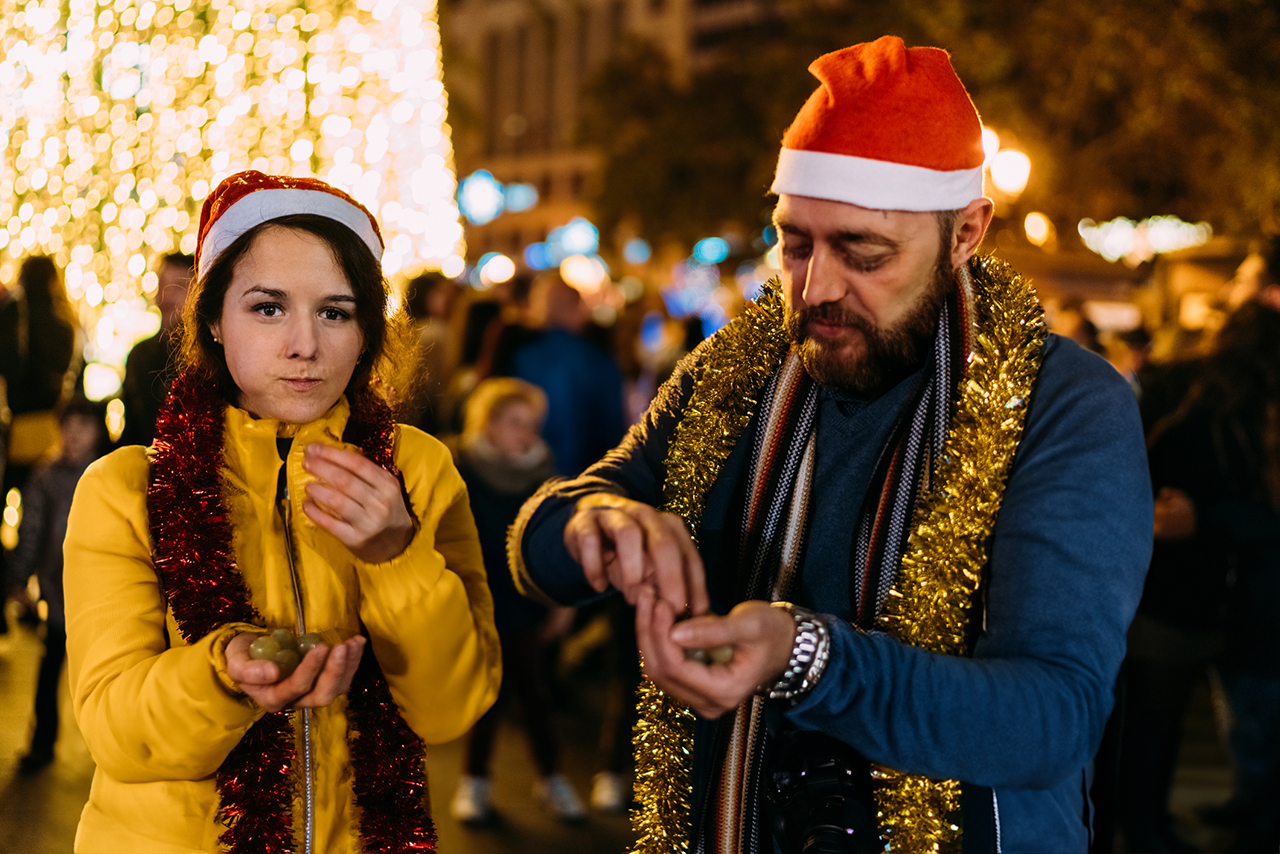Introduction
Every country has its own unique way of ringing in the New Year, but few are as punctual and delicious as Spain’s. The tradition of the campanadas and the grapes is one that has been deeply rooted in Spanish culture for over a century. As the clock strikes midnight, millions gather around their televisions or in town squares, eyes fixed on the clock, waiting for the chimes to begin. But why the rush to eat 12 grapes in the span of 12 seconds?
The act of eating a grape with each bell toll has become an integral part of Spain’s New Year’s celebration. It’s more than just a fun challenge; it’s a moment of unity, hope, and a shared experience that transcends age, background, and beliefs. This tradition, while seemingly simple, carries with it stories of history, superstition, and national identity.
For those unfamiliar with this Spanish custom, it might seem peculiar, even daunting. However, by understanding its origins and significance, one can truly appreciate the joy and excitement that comes with each grape and each chime as Spain ushers in a new year.
(For more information on Spanish traditions and cultural events, visit the official tourism website of Spain: www.spain.info.)
History of the Campanadas and the grapes
The act of consuming 12 grapes at the stroke of midnight is not just a whimsical tradition; it’s a practice deeply rooted in Spain’s history, with tales that blend fact and folklore.
Origins of the tradition
The most widely accepted origin of this tradition dates back to the early 20th century. In 1909, grape growers in the Alicante region found themselves with an unusually large grape surplus and needed a way to sell them off. They initiated the idea of consuming grapes at the stroke of midnight, promoting it as a way to celebrate the New Year and bring good luck. The idea caught on, and soon, people all over Spain were taking part in the ritual.
However, another story suggests that the tradition began as a way for the Spanish upper class to mock the French, who had a custom of consuming grapes and drinking champagne on New Year’s Eve. The Spanish, in a jesting manner, adopted the grape-eating part but added the challenge of eating them in time with the clock’s chimes.
Evolution over the years
Over the decades, the tradition of the campanadas and the grapes has become an integral part of Spain’s New Year’s celebrations. What began as a simple act has transformed into a national event, broadcasted live on television, with thousands gathering in major squares, especially in Madrid’s Puerta del Sol, to participate together.
The ritual has also seen variations. Some people prefer to eat white grapes for good luck, while others insist on peeling and de-seeding them first. There are even canned, pre-peeled grapes available for those who wish to prepare in advance!
Regardless of its true origins or the ways it has evolved, the act of eating 12 grapes at midnight has become a cherished tradition in Spain, symbolizing hope, prosperity, and a shared cultural identity.
(For a deeper dive into Spanish traditions and their histories, the Institute of Spanish Cultural Heritage offers a wealth of information and resources.)

The ritual step by step
The tradition of eating 12 grapes at the stroke of midnight is not just a fun activity; it’s a ritual that requires precision, timing, and a bit of preparation. Here’s a breakdown of how the Spanish ensure they get their 12 grapes down in the 12 seconds of the campanadas.
Preparations leading up to the event
Before the big moment, families and individuals prepare by selecting their grapes. While some prefer the traditional method of choosing fresh grapes, others opt for the convenience of pre-packaged grapes, which are often sold specifically for this purpose in the days leading up to New Year’s Eve. It’s common for people to peel and de-seed their grapes beforehand, ensuring a smoother (and quicker) consumption.
The significance of the Puerta del Sol clock in Madrid
The clock at Puerta del Sol is not just any clock; it’s the official timekeeper for this tradition. As the clock begins to chime, signaling the end of the old year and the dawn of the new, all eyes and ears are attuned to its every tick. The clock’s chimes are broadcasted live on national television, ensuring that even those celebrating at home or in other parts of Spain can synchronize their grape-eating with the rest of the country.

How and when to eat the grapes
As the clock starts its twelve chimes, the ritual begins. With each bell strike, one grape is eaten. It’s a rapid succession, and the challenge is to swallow each grape before the next chime. By the time the clock finishes chiming, all 12 grapes should be consumed, symbolizing good luck for each month of the coming year. It’s a fun, albeit slightly frantic, moment that brings laughter, cheers, and sometimes a few playful jokes about who couldn’t keep up.
The tradition is more than just a fun challenge; it’s a moment of unity, where families, friends, and even strangers come together to bid farewell to the old year and welcome the new with hope, laughter, and a shared experience.
(For tourists interested in experiencing this tradition firsthand, the Spanish Tourism Board provides information on New Year’s Eve celebrations and events across the country.)
The significance of the 12 grapes
The act of eating 12 grapes at the stroke of midnight is not just a quirky tradition; it’s imbued with deep symbolism and hope for the future. Let’s delve into the meaning behind each grape and the wishes they represent.
Superstition and symbolism behind each grape
The tradition of eating 12 grapes dates back over a century and is deeply rooted in Spanish culture. Each grape represents a month of the coming year, and consuming all 12 is believed to bring good luck and ward off evil for each month. The rapid succession in which they are eaten is a testament to the unpredictability of life and the hope that good fortune can be achieved even in the face of challenges.
While the act itself might seem simple, the symbolism is profound. It’s a reflection of the human desire for prosperity, health, and happiness. By partaking in this ritual, individuals are not just following a tradition; they’re actively manifesting their hopes and dreams for the future.
Wishes and hopes for the upcoming year
As each grape is consumed, it’s common for individuals to silently make a wish or set an intention for the corresponding month. Some might wish for health in January, love in February, success in March, and so on. Others might focus on broader themes, like peace, happiness, or personal growth. By the time the twelfth grape is swallowed, participants have set forth a roadmap of aspirations for the year ahead.
The beauty of this tradition lies in its universality. Whether young or old, local or foreigner, everyone can understand the desire to start the year on a positive note, filled with hope and anticipation. The 12 grapes serve as a tangible reminder of the possibilities that lie ahead and the power of tradition to unite and inspire.
Regional variations and curiosities
Spain, with its rich tapestry of cultures and traditions, often showcases regional variations in its celebrations. The tradition of the 12 grapes is no exception. While the core essence remains consistent, there are intriguing differences and related customs across the country.
Is it celebrated the same way throughout Spain?
At its heart, the tradition of eating 12 grapes at midnight is consistent across Spain. As the clock strikes midnight, one grape is consumed with each chime, symbolizing good luck for the 12 months ahead. However, the way this tradition is executed can vary.
For instance, in some parts of Spain, it’s customary to wear new clothes, especially new underwear, during the New Year’s celebration. The color of the underwear can also hold significance: red for love, yellow for luck, and white for peace.
In regions like Catalonia, besides the grapes, it’s also traditional to have a piece of marzipan after the grapes, representing a sweet start to the year.
Other related traditions in different regions
While the 12 grapes are a unifying tradition, Spain’s diverse regions have their own unique customs:
- In the Basque Country, the first day of the year is celebrated with the “Mari Domingi” or “Año Nuevo” festival, where locals dress in traditional costumes and partake in dances and songs.
- In Galicia, it’s believed that the first person to enter your home after the clock strikes midnight – known as the “first-footer” – will determine the household’s luck for the year. Ideally, this person should be tall, dark-haired, and bring gifts like coins, bread, or salt.
- In the Canary Islands, the tradition is quite similar to the mainland, but due to the time difference, many residents have the unique opportunity to celebrate twice: once with the Peninsular Spain timings and once with their local time.
These regional quirks add layers of richness to the overarching tradition, making the New Year’s celebration in Spain a diverse and fascinating affair.
How to experience it as a tourist
For those visiting Spain during the New Year’s Eve celebrations, the tradition of the 12 grapes offers a unique cultural experience. Here’s how you can immerse yourself in this iconic Spanish custom and make the most of your visit.

Tips for enjoying the Campanadas in different spanish cities
- Madrid: The epicenter of the celebration is the Puerta del Sol. Arrive early to secure a good spot, as thousands gather here. The atmosphere is electric, and the collective act of eating grapes in unison is unforgettable. Remember to bring your own grapes!
- Barcelona: Head to Plaça de Catalunya. While the grape tradition is observed, you’ll also witness a blend of Catalan customs. After the grapes, enjoy the fireworks and continue the night at one of the city’s vibrant parties.
- Seville: The Plaza Nueva becomes a hub of festivities. With the Seville Cathedral as your backdrop, the experience is both scenic and festive.
- Valencia: The Plaza del Ayuntamiento is where locals gather. After the grapes, stay for the fireworks and music.
Related events and festivities
- Nochevieja Universitaria in Salamanca: Held in early December, this event sees thousands of students gathering in Plaza Mayor to do a mock grape-eating tradition, ensuring they’re well-practiced for the real deal.
- San Silvestre Vallecana in Madrid: Before the evening’s festivities, participate or cheer on participants in this famous 10k run.
- Dance the Night Away: Post grape-eating, many cities host parties and events. Consider booking a ticket to a local “cotillón de nochevieja” – a traditional New Year’s Eve party with music, dancing, and often, breakfast served after midnight.
- Daytime on New Year’s Day: After a late night, start the New Year with a leisurely day visiting open attractions. Many Spaniards enjoy a family meal on January 1st, so be sure to book restaurants in advance.
For detailed event listings and to plan your New Year’s Eve in Spain, the Spanish Tourism Board offers comprehensive guides and recommendations. Embrace the tradition, and let the chimes of the clock lead you into a prosperous New Year in Spain!
Conclusion
The act of consuming 12 grapes at the stroke of midnight is not just a quirky tradition; it’s a testament to Spain’s rich tapestry of cultural and social customs. This ritual, observed by millions, transcends age and background, uniting the nation in hope, festivity, and collective aspiration.
The cultural significance of this tradition is profound. It’s a moment that captures the essence of Spain’s zest for life, its embrace of the past, and its hopes for the future. It’s a blend of old-world charm and contemporary celebration, a ritual that has evolved yet remained deeply rooted in its origins.
Moreover, the social aspect of this tradition cannot be understated. Families gather, friends reunite, and even strangers on the streets share in this collective experience. It’s a moment of unity, where the entire nation, for 12 seconds, is synchronized in hope and celebration.
For tourists, participating in this tradition offers a unique window into the Spanish soul. It’s an opportunity to step beyond the role of a mere observer and to actively engage in a ritual that has been celebrated for over a century.
So, as the year draws to a close and the chimes of the clock beckon, we invite you to immerse yourself in this enchanting tradition. Stand shoulder to shoulder with the locals, grape in hand, and usher in the New Year the Spanish way. Let each grape symbolize a wish, a dream, or a memory, and may the coming year be as sweet and fulfilling as the taste of those 12 grapes.
For more insights and to truly understand the depth of Spanish traditions, consider visiting the Spanish Tourism Board. Dive deep, celebrate heartily, and let Spain’s rich traditions become a part of your own story.





